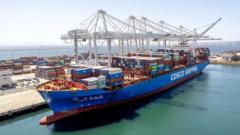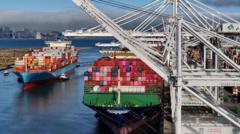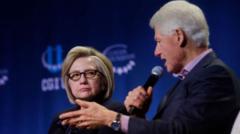The U.S. Trade Representative has outlined a plan to levy port fees on Chinese vessels, seeking to mitigate China’s shipbuilding dominance and detail the gradual rise of these fees over the next three years.
US to Impose Port Fees on Chinese Ships to Level Playing Field

US to Impose Port Fees on Chinese Ships to Level Playing Field
New tariffs aim to bolster American shipbuilding while impacting global trade dynamics.
The Trump administration has announced a strategy to impose port fees on ships built in China, aiming to strengthen U.S. shipbuilding capacities. As part of this initiative, the U.S. Trade Representative (USTR) disclosed that the fees, which will begin in 180 days, are less severe than earlier proposals suggesting fees of up to $1.5 million for each U.S. port visited by Chinese vessels.
The new measures aim to counteract China's near dominance in the shipbuilding sector, which U.S. officials argue severely disadvantages American companies and workers. The imposed fees will vary based on cargo weight or the number of containers and vehicles on the vessels. Specifically, bulk carriers will incur fees based on tonnage, while container ships will be charged per container.
Initially, the fees for Chinese-owned vessels will be set at $50 per ton of cargo, increasing $30 annually over three years. For ships constructed in China, the starting fee is $18 per ton or $120 per container. Additionally, vehicles transported on non-U.S. built ships will be subject to a charge of $150 each, applicable once per voyage up to six times a year.
Notably, empty vessels arriving at U.S. ports will be exempt, as will bulk carriers destined for exports like coal or grain. The USTR plans a subsequent phase to favor U.S.-built ships in liquefied natural gas transport, mandating adherence to stricter restrictions over the next 22 years.
Experts warn that these fees could exacerbate ongoing disruptions in global trade, particularly amid Trump's existing tariff policies. Cargo originally sent from China to the U.S. is being redirected to European ports, leading to increased shipping costs for American consumers.
Marco Forgione, director general of the Chartered Institute of Export & International Trade, noted a "significant build-up" of vessels in Europe and the U.K., as firms navigate the complexities of Trump's tariffs, which can reach up to 245% for certain Chinese imports.
Logistics executives, like Sanne Manders of Flexport, have highlighted ongoing congestion in key European ports such as Rotterdam and Barcelona, attributing it to both tariffs and strikes. As businesses explore alternative markets, the potential for U.S. consumer prices to rise remains a pressing concern, while European consumers may experience minimal impact.
Shipping companies appear ready to modify their supply chains in response to the evolving landscape of tariffs and port regulations.
The new measures aim to counteract China's near dominance in the shipbuilding sector, which U.S. officials argue severely disadvantages American companies and workers. The imposed fees will vary based on cargo weight or the number of containers and vehicles on the vessels. Specifically, bulk carriers will incur fees based on tonnage, while container ships will be charged per container.
Initially, the fees for Chinese-owned vessels will be set at $50 per ton of cargo, increasing $30 annually over three years. For ships constructed in China, the starting fee is $18 per ton or $120 per container. Additionally, vehicles transported on non-U.S. built ships will be subject to a charge of $150 each, applicable once per voyage up to six times a year.
Notably, empty vessels arriving at U.S. ports will be exempt, as will bulk carriers destined for exports like coal or grain. The USTR plans a subsequent phase to favor U.S.-built ships in liquefied natural gas transport, mandating adherence to stricter restrictions over the next 22 years.
Experts warn that these fees could exacerbate ongoing disruptions in global trade, particularly amid Trump's existing tariff policies. Cargo originally sent from China to the U.S. is being redirected to European ports, leading to increased shipping costs for American consumers.
Marco Forgione, director general of the Chartered Institute of Export & International Trade, noted a "significant build-up" of vessels in Europe and the U.K., as firms navigate the complexities of Trump's tariffs, which can reach up to 245% for certain Chinese imports.
Logistics executives, like Sanne Manders of Flexport, have highlighted ongoing congestion in key European ports such as Rotterdam and Barcelona, attributing it to both tariffs and strikes. As businesses explore alternative markets, the potential for U.S. consumer prices to rise remains a pressing concern, while European consumers may experience minimal impact.
Shipping companies appear ready to modify their supply chains in response to the evolving landscape of tariffs and port regulations.




















